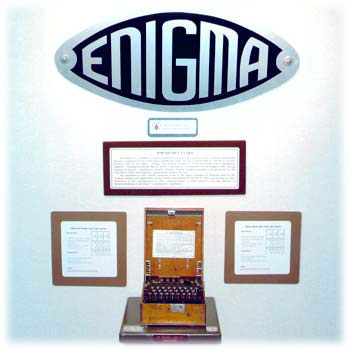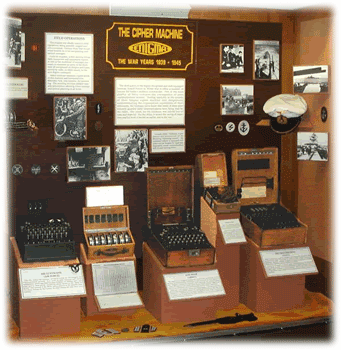

 Possibly
the most well known of all cipher machines is the German Enigma. It became
the workhorse of the German military services, used to encrypt tens of
thousands of tactical messages throughout World War II. The number of mathematical
permutations for every keystroke is astronomical. However, the Enigma is
not famous for its outstanding security, but rather for its insecurities.
Allied forces were able to read most of the Enigma encrypted messages throughout
most of the war as a result of the tireless effort of many Allied cryptologists.
Possibly
the most well known of all cipher machines is the German Enigma. It became
the workhorse of the German military services, used to encrypt tens of
thousands of tactical messages throughout World War II. The number of mathematical
permutations for every keystroke is astronomical. However, the Enigma is
not famous for its outstanding security, but rather for its insecurities.
Allied forces were able to read most of the Enigma encrypted messages throughout
most of the war as a result of the tireless effort of many Allied cryptologists.
The principles on which The Enigma were based would make it seem like an uncompromising and secure device. It is an electromechanical machine that used a combination of wired rotors and plugs to change each letter as it is typed. The encryption process began by depressing a lettered key that generated an electrical current. The current passed through a plugboard and three rotors, a reflecting plate, and back through the three rotors and plugboard. The “letter” changed each time it encountered a plug, rotor, and the reflecting plate. Eventually, the cipher letter was illuminated on a light panel and the operator wrote that letter down. Because the first of the three rotors moved with each keystroke, the cipher letter changed, even if the same letter key was repeated.
 The
Germans had five (and the German Navy, eight) wired rotors from which to
select three to be placed in the machine each day. A keylist was provided
to each radio network for its Enigma units, telling the operator which rotors
and plug settings to use that day. The Germans believed that, without the
keylist, the Allies could never break the Enigma enciphered messages. Their
unswerving belief in the machine’s security proved to be their failing.
The
Germans had five (and the German Navy, eight) wired rotors from which to
select three to be placed in the machine each day. A keylist was provided
to each radio network for its Enigma units, telling the operator which rotors
and plug settings to use that day. The Germans believed that, without the
keylist, the Allies could never break the Enigma enciphered messages. Their
unswerving belief in the machine’s security proved to be their failing.
Beginning in 1928, the Polish Cipher Bureau began working to break the Enigma messages. In 1932, they assigned three mathematicians to do the work. They succeeded. Little more than one month before the outbreak of WWII, the Polish passed their secret to France and Britain. Despite the improvements made by the Germans during the war, Britain was able to continue finding the Enigma settings (without capturing keylists) and reading the Germans’ messages. By the time the United States entered the war, the U-boat Enigmas had become even more complicated by the addition of a fourth rotor. Beginning in the fall of 1943, and for the rest of the war, the responsibility of solving the U-boat messages fell to the U.S. Navy. Breaking the four-rotor messages led directly to the Allies’ victory in the Battle of the Atlantic.
Today, many historians believe that the Allies’ ability to read the Enigma-enciphered messages and act on that information shortened the war by as many as two years, saving thousands of Allied and Axis lives.